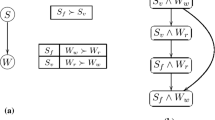
Overview
- Authors among the leading scientists and educators in the field
- Techniques applicable in software engineering, concurrent and distributed systems, and visual modelling
- Comprehensive treatment, includes a brief introduction to category theory
Part of the book series: Monographs in Theoretical Computer Science. An EATCS Series (EATCS)
Access this book
Tax calculation will be finalised at checkout
Other ways to access
About this book
This book is a comprehensive explanation of graph and model transformation. It contains a detailed introduction, including basic results and applications of the algebraic theory of graph transformations, and references to the historical context. Then in the main part the book contains detailed chapters on M-adhesive categories, M-adhesive transformation systems, and multi-amalgamated transformations, and model transformation based on triple graph grammars. In the final part of the book the authors examine application of the techniques in various domains, including chapters on case studies and tool support.
The book will be of interest to researchers and practitioners in the areas of theoretical computer science, software engineering, concurrent and distributed systems, and visual modelling.
Similar content being viewed by others
Keywords
Table of contents (12 chapters)
-
Front Matter
-
Introduction to Graph and Model Transformation
-
Front Matter
-
-
$$\mathcal{M}$$ -Adhesive Transformation Systems
-
Front Matter
-
-
<InlineEquation ID="IEq1"><EquationSource Format="TEX"><![CDATA[$$\mathcal{M}$$]]></EquationSource></InlineEquation>-Adhesive Transformation Systems
-
Model Transformation Based on Triple Graph Grammars
-
Front Matter
-
-
Application Domains, Case Studies and Tool Support
-
Front Matter
-
-
Back Matter
Reviews
“The book is a comprehensive mathematical introduction to graph transformation and model transformations. … I must say that the text is written in a clear and well-structured manner; as such, it can be a valuable addition to the bookshelf of any researcher from mathematics or theoretical computer science or those practitioners who develop parallel code for visual modeling.” (Alexander Tzanov, Computing Reviews, computingreviews.com, October, 2016)
“The text is very coherent and uses a unified notation throughout. The language is easily understandable and examples and illustrations are generously used in all parts of the book. Any graduate of computer science should, in principle, be able to appreciate the contents of the book … .” (Andreas Maletti, zbMATH 1341.68002, 2016)
Authors and Affiliations
Accessibility Information
Bibliographic Information
Book Title: Graph and Model Transformation
Book Subtitle: General Framework and Applications
Authors: Hartmut Ehrig, Claudia Ermel, Ulrike Golas, Frank Hermann
Series Title: Monographs in Theoretical Computer Science. An EATCS Series
DOI: https://doi.org/10.1007/978-3-662-47980-3
Publisher: Springer Berlin, Heidelberg
eBook Packages: Computer Science, Computer Science (R0)
Copyright Information: Springer-Verlag Berlin Heidelberg 2015
Hardcover ISBN: 978-3-662-47979-7Published: 30 December 2015
Softcover ISBN: 978-3-662-56910-8Published: 29 March 2019
eBook ISBN: 978-3-662-47980-3Published: 21 December 2015
Series ISSN: 1431-2654
Series E-ISSN: 2193-2069
Edition Number: 1
Number of Pages: XI, 472
Number of Illustrations: 460 b/w illustrations, 5 illustrations in colour
Topics: Theory of Computation, Software Engineering/Programming and Operating Systems, Category Theory, Homological Algebra



